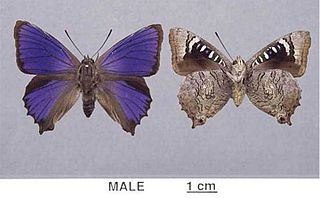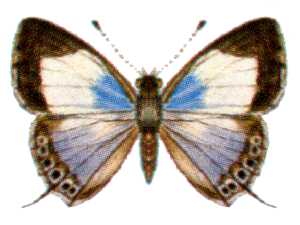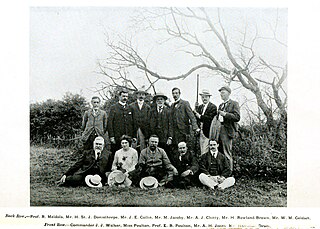
Lycaenidae is the second-largest family of butterflies, with over 6,000 species worldwide, whose members are also called gossamer-winged butterflies. They constitute about 30% of the known butterfly species.

Riodinidae is the family of metalmark butterflies. The common name "metalmarks" refers to the small, metallic-looking spots commonly found on their wings. The 1,532 species are placed in 146 genera. Although mostly Neotropical in distribution, the family is also represented both in the Nearctic, Palearctic, Australasian (Dicallaneura), Afrotropic, and Indomalayan realms.

William Chapman Hewitson was a British naturalist. A wealthy collector, Hewitson was particularly devoted to Coleoptera (beetles) and Lepidoptera and, also, to birds' nests and eggs. His collection of butterflies, collected by him as well as purchased from travellers throughout the world, was one of the largest and most important of his time. He contributed to and published many works on entomology and ornithology and was an accomplished scientific illustrator.

Miletus is a genus of butterflies sometimes called brownies. Its species are found in the eastern Palearctic realm and the Indomalayan realm, and some stray east of the Wallace Line. The genus was erected by Jacob Hübner around 1819. Miletus is the type genus of the subfamily Miletinae.

Miletinae is a subfamily of the family Lycaenidae of butterflies, commonly called harvesters and woolly legs, and virtually unique among butterflies in having predatory larvae. Miletinae are entirely aphytophagous. The ecology of the Miletinae is little understood, but adults and larvae live in association with ants, and most known species feed on Hemiptera, though some, like Liphyra, feed on the ants themselves. The butterflies, ants, and hemipterans, in some cases, seem to have complex symbiotic relationships benefiting all.

Allotinus is a genus of butterflies in the family Lycaenidae. The genus was erected by Cajetan Felder and Rudolf Felder in 1865. The members (species) of this genus are found in the Indomalayan realm.

Poritia is a genus of lycaenid butterflies. The species of this genus are found in the Indomalayan realm. Poritia was erected by Frederic Moore in 1887.

Polyommatinae, the blues, are a diverse subfamily of gossamer-winged butterflies. This subfamily of butterfly was discovered in 1775. These butterflies have been considered one of the poorest studied groups within the family Lycaenidae.

Evenus is a butterfly genus in the family Lycaenidae, with species ranging from North to South America.

Lachnocnema, commonly called woolly legs, is a genus of butterflies in the family Lycaenidae found mainly in Sub-Saharan Africa. Identification requires dissection to reveal subtle genital distinctions.

George Thomas Bethune-Baker was an English entomologist who specialised in Lepidoptera, especially those in the family Lycaenidae of butterflies.

Oenomaus is a genus of butterflies in the family Lycaenidae. The species of this genus are found in the Neotropical realm.

Ogyris is an Australasian genus of butterflies in the family Lycaenidae.

Philiris is a genus of butterflies in the family Lycaenidae. The species of this genus are found in the Australasian realm, mostly inhabiting tropical rainforests. Philiris was erected by Julius Röber in 1891. It is a speciose genus. Tite decided on 56 species. Sands added 11 species and placed the taxa into 21 species groups. Most species are on New Guinea. Tite considered Philiris and Candalides Hübner, 1819 to be sisters. Eliot (1973) placed Philiris in Luciini Waterhouse & Lyell, 1914, close to Hypochrysops C. et R. Felder, 1860. Compared to other members of the tribe, Philiris have relatively uniform ventral patterns with usually silvery-white ground color.

Tajuria is an Indomalayan genus of butterflies in the family Lycaenidae.

Rachana is a genus of butterflies in the family Lycaenidae.

Jameela is a genus of butterflies in the family Lycaenidae.

Lepidoptera Indica was a 10 volume work on the butterflies of the Indian region that was begun in 1890 and completed in 1913. It was published by Lovell Reeve and Co. of London. It has been considered the magnum opus of its author, Frederic Moore, assistant curator at the museum of the East India Company. Frederic Moore described a number of new species through this publication. Moore was a splitter, known for careless creation of synonyms, sometimes placing the same species in more than one genus.

Hamilton Herbert Charles James Druce was an English entomologist who specialised in Lycaenidae and to a lesser extent Hesperiidae. He is not to be confused with his father, the English entomologist Herbert Druce (1846–1913) who also worked on Lepidoptera.

Thermozephyrus ataxus, the wonderful hairstreak, is a small butterfly found from India to Japan that belongs to the lycaenids or blues family.



















